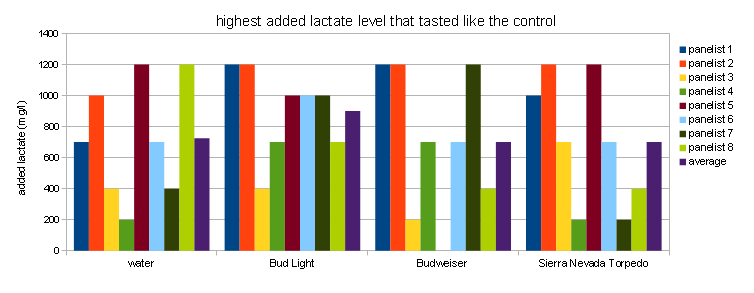Kaiser
Well-Known Member
Last weekend I did a yeast handling presentation to Brew Free Or Die club members and I took the opportunity to conduct a lactate taste threshold experiment with 8 club members. While it had little to do with the topic of the technical session it is a subject where I wanted to do some experimentation for quite some time.
Acidulated malt and 88% lactic acid are very popular acids for mash pH correction but since lactic acid has a rather distinct taste the question that is on many brewers minds is: How much lactic acid is too much.
Since in most cases lactic acid is only added to counteract water alkalinity and bring the mash pH into the desirable range of 5.3-5.5 it can be assumed that the added lactic acid will not lead to a lower than normal beer pH. In other words, we dont have to worry about beers that taste sour. But we do have to worry about the characteristic taste of lactate. Lactate is whats left when lactic acid gives up its proton to neutralize a base or contribute to pH changes.
The experiment was designed such that the acidity of the lactic acid was neutralized with slaked lime. While that also adds calcium in addition to the lactate it matches brewing reality where highly alkaline waters oftentimes come with high calcium levels. I had the choice between calcium (from slaked lime) or sodium (from sodium hydroxide). Both calcium lactate and sodium lactate tasted very similar in water which shows that sodium doesnt necessarily lead to a salty taste. I decided to go with calcium lactate since calcium is generally the dominant cation in alkaline waters.
I was very surprised to see how many of the tasters struggled with identifying the flavor in the 4 sets of samples they were given (water, Bud Light, Budweiser and Sierra Nevada Torpedo Ale). Even levels as high 1200 mg/l, which amounts to a whopping 23% acidulated malt, were not correctly identified by some tasters. Below is a link to a more formal write-up of the experiment and those interested can go ahead and check my numbers.
Here is a chart that shows for each taster the highest lactate level that was identified as tasting like the control:

After having done this experiment and having tasted samples with added lactate myself I think that a safe upper limit of 400 mg/l lactate or 7% acidulated malt is reasonable with the assumption that the mash and beer pH are at acceptable levels. While 7% is higher than the 5% that is currently seen as the safe upper limit for acidulated malt use it should be noted that there might be other benefits to reducing the amount of minerals in a given water before acidulated malt is used to neutralize the remaining alkalinity.
A formal write-up of the experiment can be found on the braukaiser.com wiki: Lactate Taste Threshold Experiment
Acidulated malt and 88% lactic acid are very popular acids for mash pH correction but since lactic acid has a rather distinct taste the question that is on many brewers minds is: How much lactic acid is too much.
Since in most cases lactic acid is only added to counteract water alkalinity and bring the mash pH into the desirable range of 5.3-5.5 it can be assumed that the added lactic acid will not lead to a lower than normal beer pH. In other words, we dont have to worry about beers that taste sour. But we do have to worry about the characteristic taste of lactate. Lactate is whats left when lactic acid gives up its proton to neutralize a base or contribute to pH changes.
The experiment was designed such that the acidity of the lactic acid was neutralized with slaked lime. While that also adds calcium in addition to the lactate it matches brewing reality where highly alkaline waters oftentimes come with high calcium levels. I had the choice between calcium (from slaked lime) or sodium (from sodium hydroxide). Both calcium lactate and sodium lactate tasted very similar in water which shows that sodium doesnt necessarily lead to a salty taste. I decided to go with calcium lactate since calcium is generally the dominant cation in alkaline waters.
I was very surprised to see how many of the tasters struggled with identifying the flavor in the 4 sets of samples they were given (water, Bud Light, Budweiser and Sierra Nevada Torpedo Ale). Even levels as high 1200 mg/l, which amounts to a whopping 23% acidulated malt, were not correctly identified by some tasters. Below is a link to a more formal write-up of the experiment and those interested can go ahead and check my numbers.
Here is a chart that shows for each taster the highest lactate level that was identified as tasting like the control:

After having done this experiment and having tasted samples with added lactate myself I think that a safe upper limit of 400 mg/l lactate or 7% acidulated malt is reasonable with the assumption that the mash and beer pH are at acceptable levels. While 7% is higher than the 5% that is currently seen as the safe upper limit for acidulated malt use it should be noted that there might be other benefits to reducing the amount of minerals in a given water before acidulated malt is used to neutralize the remaining alkalinity.
A formal write-up of the experiment can be found on the braukaiser.com wiki: Lactate Taste Threshold Experiment






























![Craft A Brew - Safale S-04 Dry Yeast - Fermentis - English Ale Dry Yeast - For English and American Ales and Hard Apple Ciders - Ingredients for Home Brewing - Beer Making Supplies - [1 Pack]](https://m.media-amazon.com/images/I/41fVGNh6JfL._SL500_.jpg)


























